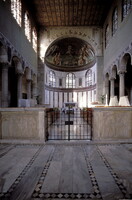| dc.description | Cosmati Choir (9th century), frontal view into the choir, with apse behind; After the official recognition of Christianity in 313 CE, the Christians, anxious to avoid architectural parallels with pagan temples, adopted exposed brick walls and the arch as major elements of their religious buildings, creating the classic basilican church of the late Roman period, for example S Sabina (ca. 425), Rome, and S Apollinare in Classe (534-536). By the late 5th century the arcade was an essential feature of Christian architecture, in both the east and west. It remained so until the 20th century. An especially fine example is the parish church of S Sabina (422-432) on top of the Aventine Hill. The spacious nave (48.0 x 13.5 m) is separated from the flanking aisles by 24 marble columns and their Corinthian capitals, which are perfectly matched spolia. A large round-headed window is positioned above each intercolumniation of the nave, and three similar windows pierce the apse wall. The spandrels of the nave arcades are covered with their original polychrome marble revetments, but the figural mosaics that decorated the upper nave walls and the semi-dome of the apse are largely lost. Although S Sabina was founded by the priest Peter of Illyrium, the dedicatory inscription begins with the name of the ruling pope Celestine I (reigned 422-432). This may reflect an unwritten understanding established in the 4th century that if a newly elected pope lacked the funds to establish a new church building, a prosperous parishioner or clergyman would provide the financial means, but the name of the pope would be conspicuously connected with the foundation. Source: Grove Art Online; http://www.groveart.com/ (accessed 2/3/2008) | en_US |


